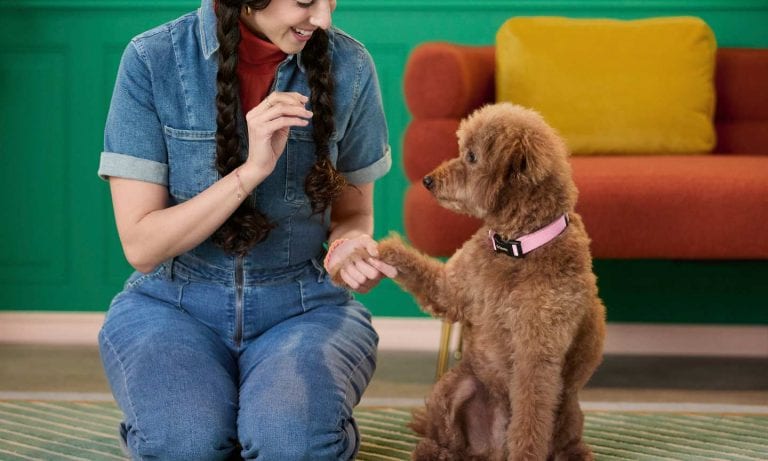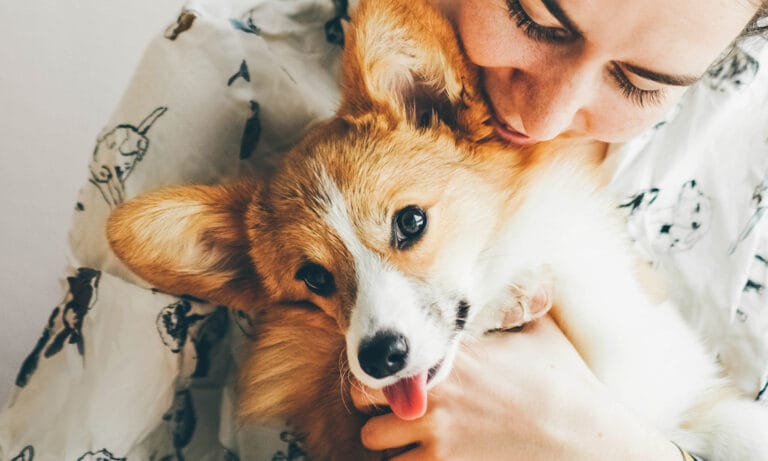In This Guide:
What Is Clicker Training?
We consulted Alexandra Bassett, a certified professional dog trainer (CPDT-KA) and the owner, lead dog trainer, and behavior consultant at virtual dog training company Dog Savvy. She says clicker training is a form of positive reinforcement training that uses a clicker to communicate with a dog about when they will earn a reward.
“A clicker, also known as a reward marker, is a small mechanical noisemaker that makes a distinct sound that’s easy for a dog to recognize. [It’s] a reproducible sound or signal that indicates to a dog that they have just earned a reward … and is meant to bridge the time gap between a dog performing a desirable behavior and the delivery of a reward.”
All kinds of animals respond to clicker training, including dogs, birds, horses, and even trained marine life like dolphins or seals. Clickers were originally developed by marine mammal trainers to communicate with and train marine mammals kept in captivity, Bassett says.
So, why does it work?
“A ‘mark and reward’ approach to dog training is based on the science of animal learning, which says that behaviors that are rewarded are more likely to be repeated in the future,” Bassett says. “[They] have become popular with animal trainers all over the world, because they make a distinct sound that is easy for animals to pick out when you are training them.”
That being said, you don’t need a clicker to teach your dog new skills. Some trainers use verbal marks like the word “yes” or “good,” which can work just as well. It’s all about preference and what’s most effective with your unique pup.
Benefits of Clicker Training
“Using a clicker can be really helpful in teaching precise behaviors,” says Leigh Siegfried, CCPDT-KA, a dog trainer and founder at full-service dog training company Opportunity Barks Behavior & Training in Philadelphia. “This is the same sound replicable again and again, [and the] idea is that the sound of the clicker, its sharpness and contrast, can be processed in the amygdala—their hindbrain.”
The consistent sound of the click is, in many ways, more reliable than a hand signal—which can differ slightly each time—even verbal praise that may vary in tone or volume. For that reason, the main benefit of clicker training for dogs is precision, as you can instantly communicate with your dog the exact moment they perform a desired action. Using this conditioned reinforcer training technique can strengthen dog parents’ bond with their pups; simplify the learning process of basic commands and new behaviors; and increase the likelihood of a dog listening to verbal commands in the future.
Clicker Training Supplies
Not all clickers are created equal. Some are louder or easier to use than others, so the type of clicker depends on the dog parent’s or trainer’s preference (and the dog’s preference as well).
“There are traditional old box clickers and then there are button clickers. I like a button clicker because it’s not as sharp,” Siegfried says. “A box clicker takes a pretty decent amount of pressure to push it … and it’s loud.”
Clicker Training a Dog: Step-by-Step Instructions
1Introduce the Clicker
Because some dogs are sound sensitive and may become agitated by the clicker, gently introduce the clicker to your dog in a safe way. Make sure you have plenty of high-value training treats nearby. In one hand, hold and click the clicker. With your other hand, immediately give your dog a high-value treat. These small steps will teach the dog to trust the clicker and associate it with a high-value reward—rather than something to be feared.
2Wait for Good Behavior
It’s time to show your dog that their behavior can lead to a click (and treat). This can be any action or activity you approve of—whether it’s staying close to your side on walks; coming when called; or even just being calm and quiet.
If your dog already knows cues like “sit,” “stay” or “lie down,” you can incorporate clicker training to reinforce those skills too. Give your cue (i.e., “sit”) and then continue to the next steps.
3Click the Clicker and Give a Treat
The click provides your dog with a sound cue to let them know they did the right thing by performing the desired behavior. If your dog performs the desired behavior, give positive reinforcement by clicking the clicker immediately. Continue the positive reinforcement by giving your dog a food reward immediately after clicking the clicker.
4Phase Out the Treats
Slowly, over time, you’ll want to remove the food reward in favor of verbal praise. Repeat steps 2 and 3, but instead of giving a food reward, give your pup lots of verbal praise, and pet or scratch them to let them know they did a good thing.
5 Phase Out the Clicker
When your dog is reliably performing the desired behavior without food rewards, begin phasing out the clicker. The goal is for your praise and attention to be their reward. So, give your dog a cue, wait for them to follow your instructions, and when they do, shower them with love—but leave the clicker out of it.
You may be wondering: What’s the value of learning with the clicker if it is just going to be phased out? Many dog trainers believe clicker training helps dogs learn faster and improves communication with your pet.
Think of it as a type of treat for your pup: When you’re first house-training a puppy, for example, you might give them a treat every time they successfully go potty outside. However, you wouldn’t continue that reward for the rest of their life; eventually, they learn to go outside, and that reward is phased out when they prove they know what to do. It’s the same concept with a clicker.
“I have found the clicker useful for marking precision behaviors, and to get things off the ground and rolling with a dog,” Siegfried says. “It’s not a substitute for a verbal marker—like a ‘Good!’ or a ‘Yes!’ It’s not about the commands as much as it’s about the communication system.”
Tips and Tricks for Clicker Training a Dog
Consistent, short bursts of training are typically the most effective for teaching your dog a new behavior. Siegfried recommends keeping training sessions short—just a few minutes at a time—with play breaks in between.
“Stop your session, and play with your dog or intersperse training and playing through sessions,” Siegfried says. According to Siegfried, the ultimate goal for clicker training is to “have an anticipatory response where you click and the dog looks at you” and immediately performs the desired action.
Timing is also a crucial element in clicker training for dogs. If you press the clicker too early or too late, you may confuse your dog about what the good behavior actually is. Practice and watch your dog for signs of understanding (or confusion) to help get the timing right, so your dog can clearly understand what the good behavior is.
What if My Dog’s Not Getting It?
If your dog is not catching on to clicker training after several sessions, it may be time to bring in a professional dog trainer.
“If undesired behaviors are not decreasing and desired behaviors are not increasing, then they absolutely should work with a professional,” Siegfried says. Check out our tips for finding a great dog trainer.
Now that you’re ready to start clicker training, it’s time to decide what to teach your dog first! Check out all the fun new dog training skills they can learn.
Expert input provided by Alexandra Bassett, a certified professional dog trainer (CPDT-KA) and the owner, lead dog trainer and behavior consultant at virtual dog training company Dog Savvy; and Leigh Siegfried, certified dog trainer and founder at full-service dog training company Opportunity Barks Behavior & Training in Philadelphia.
More Training Tips
Share:























